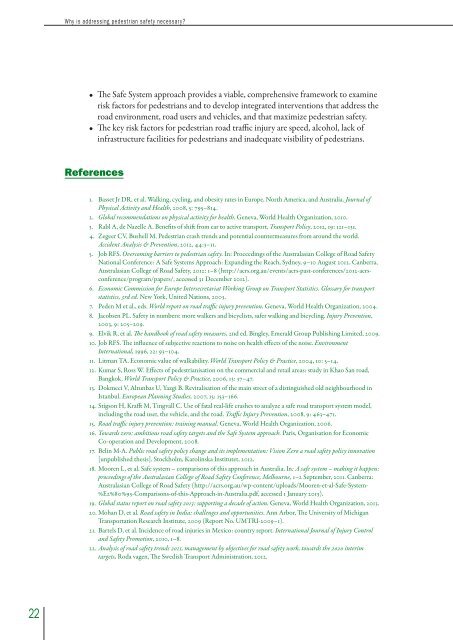Pedestrian safety - Global Road Safety Partnership
Pedestrian safety - Global Road Safety Partnership
Pedestrian safety - Global Road Safety Partnership
Create successful ePaper yourself
Turn your PDF publications into a flip-book with our unique Google optimized e-Paper software.
Why is addressing pedestrian <strong>safety</strong> necessary?<br />
• The Safe System approach provides a viable, comprehensive framework to examine<br />
risk factors for pedestrians and to develop integrated interventions that address the<br />
road environment, road users and vehicles, and that maximize pedestrian <strong>safety</strong>.<br />
• The key risk factors for pedestrian road traffic injury are speed, alcohol, lack of<br />
infrastructure facilities for pedestrians and inadequate visibility of pedestrians.<br />
References<br />
1. Basset Jr DR, et al. Walking, cycling, and obesity rates in Europe, North America, and Australia. Journal of<br />
Physical Activity and Health, 2008, 5: 795–814.<br />
2. <strong>Global</strong> recommendations on physical activity for health. Geneva, World Health Organization, 2010.<br />
3. Rabl A, de Nazelle A. Benefits of shift from car to active transport. Transport Policy, 2012, 19: 121–131.<br />
4. Zegeer CV, Bushell M. <strong>Pedestrian</strong> crash trends and potential countermeasures from around the world.<br />
Accident Analysis & Prevention, 2012, 44:3–11.<br />
5. Job RFS. Overcoming barriers to pedestrian <strong>safety</strong>. In: Proceedings of the Australasian College of <strong>Road</strong> <strong>Safety</strong><br />
National Conference: A Safe Systems Approach: Expanding the Reach, Sydney, 9–10 August 2012. Canberra,<br />
Australasian College of <strong>Road</strong> <strong>Safety</strong>, 2012: 1–8 (http://acrs.org.au/events/acrs-past-conferences/2012-acrsconference/program/papers/,<br />
accessed 31 December 2012).<br />
6. Economic Commission for Europe Intersecretariat Working Group on Transport Statistics. Glossary for transport<br />
statistics, 3rd ed. New York, United Nations, 2003.<br />
7. Peden M et al., eds. World report on road traffic injury prevention. Geneva, World Health Organization, 2004.<br />
8. Jacobsen PL. <strong>Safety</strong> in numbers: more walkers and bicyclists, safer walking and bicycling. Injury Prevention,<br />
2003, 9: 205–209.<br />
9. Elvik R, et al. The handbook of road <strong>safety</strong> measures, 2nd ed. Bingley, Emerald Group Publishing Limited, 2009.<br />
10. Job RFS. The influence of subjective reactions to noise on health effects of the noise. Environment<br />
International, 1996, 22: 93–104.<br />
11. Litman TA. Economic value of walkability. World Transport Policy & Practice, 2004, 10: 5–14.<br />
12. Kumar S, Ross W. Effects of pedestrianisation on the commercial and retail areas: study in Khao San road,<br />
Bangkok. World Transport Policy & Practice, 2006, 13: 37–47.<br />
13. Dokmeci V, Altunbas U, Yazgi B. Revitalisation of the main street of a distinguished old neighbourhood in<br />
Istanbul. European Planning Studies, 2007, 15: 153–166.<br />
14. Stigson H, Krafft M, Tingvall C. Use of fatal real-life crashes to analyze a safe road transport system model,<br />
including the road user, the vehicle, and the road. Traffic Injury Prevention, 2008, 9: 463–471.<br />
15. <strong>Road</strong> traffic injury prevention: training manual. Geneva, World Health Organization, 2006.<br />
16. Towards zero: ambitious road <strong>safety</strong> targets and the Safe System approach. Paris, Organisation for Economic<br />
Co-operation and Development, 2008.<br />
17. Belin M-A. Public road <strong>safety</strong> policy change and its implementation: Vision Zero a road <strong>safety</strong> policy innovation<br />
[unpublished thesis]. Stockholm, Karolinska Institutet, 2012.<br />
18. Mooren L, et al. Safe system – comparisons of this approach in Australia. In: A safe system – making it happen:<br />
proceedings of the Australasian College of <strong>Road</strong> <strong>Safety</strong> Conference, Melbourne, 1–2 September, 2011. Canberra:<br />
Australasian College of <strong>Road</strong> <strong>Safety</strong> (http://acrs.org.au/wp-content/uploads/Mooren-et-al-Safe-System-<br />
%E2%80%93-Comparisons-of-this-Approach-in-Australia.pdf, accessed 1 January 2013).<br />
19. <strong>Global</strong> status report on road <strong>safety</strong> 2013: supporting a decade of action. Geneva, World Health Organization, 2013.<br />
20. Mohan D, et al. <strong>Road</strong> <strong>safety</strong> in India: challenges and opportunities. Ann Arbor, The University of Michigan<br />
Transportation Research Institute, 2009 (Report No. UMTRI-2009–1).<br />
21. Bartels D, et al. Incidence of road injuries in Mexico: country report. International Journal of Injury Control<br />
and <strong>Safety</strong> Promotion, 2010, 1–8.<br />
22. Analysis of road <strong>safety</strong> trends 2011, management by objectives for road <strong>safety</strong> work, towards the 2020 interim<br />
targets. Roda vagen, The Swedish Transport Administration, 2012.<br />
22






